India’s payments sector has proven to be challenging for U.S. tech giants like Facebook, WhatsApp, and Amazon, with only Google having established a strong foothold. However, Amazon is making efforts to explore India’s payments market by applying for necessary licenses and exploring partnerships with local players. This strategy could allow Amazon to build a full-fledged payments ecosystem in India.
Despite Amazon Pay lagging behind competitors like Google Pay, PhonePe, and Paytm in the retail payments segment, Amazon has received a payments aggregator license from the Reserve Bank of India. This allows Amazon to operate as an intermediary between merchants and payment processors, enabling the company to process e-commerce payments for sellers on its app as well as serve direct-to-consumer sellers. With Amazon’s significant share of the e-commerce market in India, there are ample opportunities in the merchant payments segment.
In addition to focusing on standard e-wallet features and buy now, pay later options, Amazon is now showing interest in the credit card segment in India. The company recently launched an Amazon Pay ICICI Bank co-branded credit card and is exploring a credit card tie-up with the National Payments Corporation of India. With India’s credit card penetration on the rise, there is potential for significant growth in this segment as the country’s population becomes wealthier.
Integrating credit cards with NPCI’s Unified Payments Interface (UPI) is crucial for the future prospects of credit cards in India. The dominance of UPI in India’s payments landscape means that if credit cards gain a strong foothold on the platform, they are likely to penetrate deeper into the market. In-Solutions Global Ltd estimates a 30-fold increase in credit card acceptance in India if credit cards are integrated with UPI, potentially opening up new opportunities for Amazon’s credit card initiatives.
Amazon’s new initiatives in India’s payments market will take time to bear fruit, given the intense competition and the need for subsidies to gain traction in the credit card segment. On the merchant side, Amazon may be able to take advantage of Paytm’s loss of its payments bank to attract more merchants to its network. While competition in UPI retail payments remains strong, regulatory actions to reduce dominance by Google Pay and PhonePe could potentially create opportunities for other players in the market, including Amazon. However, the focus would likely be on boosting India’s fintech startups rather than helping other tech giants increase their presence.













